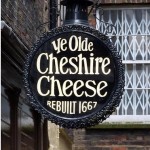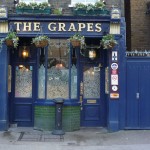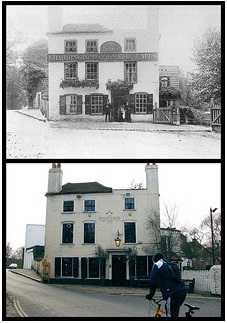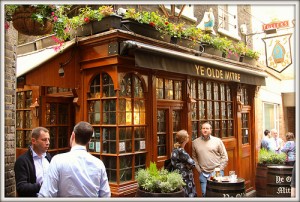 London in the 1600s brings to mind rats, the stench of rubbish, crowded streets, outbreaks of bubonic plague, the Great Fire, Shakespeare, horse-drawn carriages, dim light of oil lamps hanging outside houses and, of course, pub culture, which has continually played an important role in British history. It may have set the scene for bar fights, gambling and other debauchery, but pubs have long been the setting for great literary and artistic inspiration and where many great business ideas have been born. Queen Victoria once said: “Give my people plenty of beer, good beer, and cheap beer, and you will have no revolution among them.” So which ones are the oldest pubs in London? The title has long been a debate, but many of the oldest surviving pubs stretch back to the 1600s, 1500s and beyond. Here’s a list of 15 notable historic London pubs in no particular order:
London in the 1600s brings to mind rats, the stench of rubbish, crowded streets, outbreaks of bubonic plague, the Great Fire, Shakespeare, horse-drawn carriages, dim light of oil lamps hanging outside houses and, of course, pub culture, which has continually played an important role in British history. It may have set the scene for bar fights, gambling and other debauchery, but pubs have long been the setting for great literary and artistic inspiration and where many great business ideas have been born. Queen Victoria once said: “Give my people plenty of beer, good beer, and cheap beer, and you will have no revolution among them.” So which ones are the oldest pubs in London? The title has long been a debate, but many of the oldest surviving pubs stretch back to the 1600s, 1500s and beyond. Here’s a list of 15 notable historic London pubs in no particular order:
Photo courtesy of Peter Thompson
The White Hart
The White Hart traces its roots to 1216, claiming itself the “oldest licensed premises in London” where the city’s notorious highwaymen and rogues wet their lips. One of these notorious highwaymen was regular customer Richard (Dick) Turpin (whose life later ended in execution for horse theft). The White Hart serves food as well as drinks in Covent Garden’s Theatre Land.
191 Drury Lane, London WC2B 5QD
The Red Lion
A pub has functioned on the site of The Red Lion since 1434. As the closest pub to 10 Downing Street, its received visits form most prime ministers, but its usual clientele of tourists and civil servants typically talk more sport than politics.
48 Parliament Street, SW1A 2NH
The Cittie of Yorke
A pub has been on this Holborn site since 1430. It is housed in an atmospheric Grade II listed building with stone floors, a high-ceilinged main bar and small, dark alcoves, old wine barrels and a faux Tudor façade, mixing elements of the old and new.
22 High Holborn, WC1V 6BN
Prospect of Whitby
Dating back to 1520, The Prospect of Whitby claims to be the oldest surviving riverside tavern. It was originally called Devil’s Tavern and was a meeting place for sailors and smugglers. It also attracted artists. J. M. W. Turner and James Whistler each sketched views from pub.
57 Wapping Wall, E1W 3SH
Ye Olde Mitre
Called “London’s most hidden pub”, Ye Olde Mitre traces its history back to 1546 when it was built for the servants of the Palace of the Bishops of Ely. In recent history this secret gem has been featured in films “Snatch” and “Deep Blue Sea”.
1 Ely Court, Ely Place, EC1N 6SJ
Photo courtesy of Tony Avon
Grapes
 This narrow pub, founded in 1583, survived the Blitz bombing of the Second World War and the more recent chaos of the Docklands redevelopment. Rumour has it that Charles Dickens stood on a table to sing to customers as a child and Grapes appeared in his novel “Our Mutual Friend”.
This narrow pub, founded in 1583, survived the Blitz bombing of the Second World War and the more recent chaos of the Docklands redevelopment. Rumour has it that Charles Dickens stood on a table to sing to customers as a child and Grapes appeared in his novel “Our Mutual Friend”.
76 Narrow Street, E14 8BP
Photo courtest of Carol King
Spaniards Inn
This popular pub was built in 1585. Keats wrote “Ode to a Nightingale” in the beer garden of the Spaniard’s Inn near Hampstead Heath. It’s mentioned in Dracula and Dicken’s The Pickwick Papers. Legend has it that Dick Turpin was born here when his father was the landlord.
Spaniards Road, NW3 7JJ
Photo courtesy of Tetramesh
Seven Stars
Narrowly escaping demise in the Great Fire like many of London’s oldest pubs, Seven Stars is said to have existed since 1602. Now, located behind the Royal Courts of Justice, this tiny old pub is frequented by barristers and their clients. Keep an eye open for resident cat Tom Paine.
53 Carey Street, WC2A 2JB
Lamb and Flag
Once called the Bucket of Blood, the Lamb and Flag , licensed in 1623, was a stage for bare-knuckle fights. Poet John Dryden famously survived a heavy beating here. Now a room is named after him in his honour.
33 Rose Street, WC2E 9EB
The Bell
Parts of this small drinking joint, likely built in the 1660s, survived the Great Fire. It used to be a riverside pub when the Thames was much wider. The Bell attracts local city workers and maintains a very traditional atmosphere with an old-fashioned bar.
29 Bush Lane, EC4R 0AN
Ye Olde Cheshire Cheese
The cellar of Ye Old Cheshire Cheese – with its labyrinth of low-ceilinged rooms – dates back to a thirteenth-century monastery followed by a different pub called The Horn. After being destroyed in The Great Fire, it was rebuilt in 1667 under its current name. Many famous journalists and literary figures such as Mark Twain, G. K. Chesterton and Dr. Samuel Johnson frequented the pub.
145 Fleet Street, EC4A 2BU
The George Inn Yard
A National Trust property, The George Inn Yard is the last remaining galleried coaching inn in London. Another pub sadly destroyed in the Great Fire, it was rebuilt in 1667 and frequented by Charles Dickens (who seemed to be a regular at many old London pubs). Tucked away in a cobbled courtyard, The George Inn Yard features latticed windows and old oak beams.
77 Borough High Street SE1 1NH
The Old Bell Tavern
Designed by Sir Christopher Wren, the Old Bell Tavern was built in 1670 for the workers reconstructing St. Bride’s church after the Great Fire. It’s located in an area historically associated with journalists who worked and drank nearby/ One of the first printing presses operated here in the 1500s.
95 Fleet Street, EC4Y 1DH
The Anchor
A decade before The Anchor was destroyed in its own fire, Samuel Pepys witnessed the Great Fire rip through London from here. Many additions have been made to the original building, which had to be reconstructed in 1676, The pub’s South Bank location makes it a draw for passing tourists.
34 Southwark Bridge Road, SE1 9EF
The Lamb
Built in the 1720s, the pub (and the street it’s on) was named after philanthropist William Lamb who improved the local conduit for fresh water. Its interior features etched glass snob screens, leather sofas and a working Victorian jukebox in one corner.
94 Lamb’s Conduit Street, WC1N 3LZ
Written by Stephanie Sadler http://littlelondonobservationist.wordpress.com
